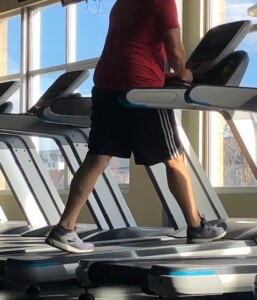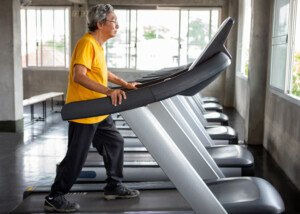
Just how much must you walk on a treadmill before this becomes potentially harmful to your knees?
Of course, this assumes that you have healthy knees to begin with, rather than the painful bone-on-bone disease of osteoarthritis and in need of knee replacement surgery.
Perhaps too much of a good thing (walking) can ultimately prove detrimental, but we have to be realistic here.
If you’re concerned about damaging your knees from excessive walking on a treadmill, you must ask yourself this question:
Just how much time do you plan on devoting to walking? When I was a personal trainer at a gym, I noticed that a woman was on a treadmill for three to four hours on most of the days that I was there.
I learned that she was training for a walk-a-thon. You don’t ever want to attempt a walk-a-thon without training for it, and she was doing the right thing.
I have spent a total of up to four and a half hours in a single day walking on my treadmill desk – not at a fitness-walking level, but at a “prevent the sitting disease” level.

Excess sitting can be offset with a treadmill desk. Shutterstock/ Uncle Leo
This means a walk as slow as one mph but also up to 2.3 mph, while I conduct computer work.
There is no harm in spending eight hours a day using a treadmill desk in this fashion – and hopefully you know how harmful sitting eight hours a day is!
Just make sure that you’re wearing supportive shoes designed for extended periods of walking.
“The question about the relationship between walking or running and arthritis is often debated,” says John-Paul H. Rue, MD, orthopedic sports medicine surgeon with Orthopedics and Joint Replacement at Mercy Medical Center in Baltimore, MD.
“There’s no evidence that moderate exercise, whether it’s running or walking, causes arthritis,” continues Dr. Rue. “In fact, the old adage that ‘motion is lotion’ holds true.
“It’s important to remain active and walking is a big part of that. Walking can help you maintain a healthy weight, which can decrease the amount of stress on your joints and actually lessen the amount of pain and stiffness you feel from your arthritis.
“Walking on a treadmill offers many advantages to people who live in colder climates or live in areas where walking outdoors just isn’t feasible.”
Do not hold onto the treadmill.
This will alter natural biomechanics and pave the way for possible repetitive stress injuries in the hips and feet.

Walking fast while holding on does NOT undo the harm of holding on.
It’s make-believe walking and deactivates the body’s balance mechanism. Holding onto a treadmill mimics using a walker!
“There are some key points to remember, however about walking on a treadmill,” says Dr. Rue.
“Make sure that you do a proper warmup and stretch, and choose a treadmill that is well-maintained.
“It’s also important to wear appropriate shoes and maintain your posture [which is possible only when you do NOT hold on, since a hands-free walk promotes good posture].
“Slouching [which holding onto the machine often leads to] can cause other areas of your body, such as your back, to hurt.
“Walking on an incline may be more of a workout, but be careful about doing this too much because the constant ‘uphill’ forces can cause ankle pain or other areas of your body to hurt from additional stress.”
Holding on will not eliminate these possibilities; keep your hands off but slow down or take a break.
 Dr. Rue specializes in prevention and treatment of sports and exercise injuries. His primary focuses are knee, shoulder and elbow injuries including ACL and cartilage injuries, rotator cuff injuries and overuse tendonitis.
Dr. Rue specializes in prevention and treatment of sports and exercise injuries. His primary focuses are knee, shoulder and elbow injuries including ACL and cartilage injuries, rotator cuff injuries and overuse tendonitis.
 Lorra Garrick is a former personal trainer certified by the American Council on Exercise. At Bally Total Fitness she trained clients of all ages for fat loss, muscle building, fitness and improved health.
Lorra Garrick is a former personal trainer certified by the American Council on Exercise. At Bally Total Fitness she trained clients of all ages for fat loss, muscle building, fitness and improved health.
.









































